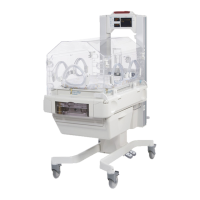3-1Girae Warmer
Chapter 3
Operating the Warmer
__________________________________________
Basic Operating Procedure
WARNING:
Always set the brakes before placing a patient in the unit.
WARNING:
Do not leave the patient unattended when using the Girae Warmer.
WARNING:
Check the patient’s temperature periodically with an independent monitor to ensure
the comfort and the safety of the patient. If the warmer is used for an extended time, it
is recommended that the baby control mode be used. When an alarm is silenced, close
monitoring of the patient’s condition is required.
WARNING:
Use of electrosurgical units or other electrical eld radiating equipment can aect
the operation of the unit. Keep the patient probe lead as far away as possible from
electrosurgical cables. Do not allow excess electrical cables to be laid on the bed platform.
Use of electrosurgical units or other instruments that radiate electrical elds can cause
indirect heating, by several tenths of a degree of the skin temperature probe due to
absorbed electrical energy. When using these devices near the radiant warmer, operate the
warmer in Manual Mode for maximum safety and use a skin temperature probe to monitor
patient temperature. For added safety, you should consider use of the manual temperature
alarm found in the Setup menu.
WARNING:
The use of phototherapy equipment or heated mattresses may raise the patient’s
temperature. Monitor patient temperature using a skin probe.
WARNING:
Radiant warmers may increase an infant’s insensible water loss. Take appropriate measures
to maintain the patient’s uid balance while caring for them in a radiant warmer.
WARNING:
Radiant energy can adversely aect blood components. When using intravenous tubing
systems for delivery of blood components to patients occupying a warmer, shield any
tubing with aluminum foil.
WARNING:
When using a chest tube drainage system, verify that the system has adequate oor
clearance prior to transporting or activating the elevating base.

